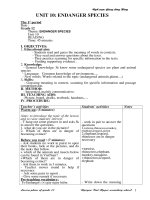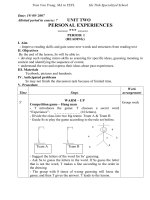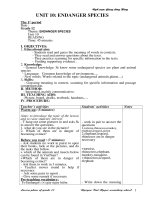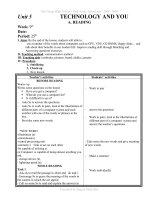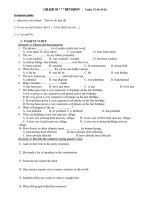unit 9-unit 11
Bạn đang xem bản rút gọn của tài liệu. Xem và tải ngay bản đầy đủ của tài liệu tại đây (186.18 KB, 31 trang )
Dak Glong High School - Dak Nong- School year: 2008 - 2009
Unit 9 DESERTS
A. READING
Week: 20
th
Date:
Period: 55
th
I. Aims: By the end of the lesson, students will able to:
- Guess the meaning in the context and decide true or false statements
- understand the humour of the story
II. Teaching method: communicative method
III. Teaching aids: textbooks, pictures, board, chalks
IV. Procedure
1. Stabilizing
2. Check-up
3. New lesson
Teacher’s activities Students’ activities
Pre- reading
- Ask students to look at the picture page 91 and ask Ss to
answer some questions:
1 What do you know about deserts?
2 what kinds of plants and animals live in a desert.
3 Name some of the countries which have eserts
- Call a pair to report their discussion
- Introduce the topic:
Deserts
- Teach some new words: ask students whether they
know the words, if they do not know them, explain in
English then ask them to give Vietnamese equivalents to
check their understanding
- strech
- sandy
- aerial survey
- Royal Giographical Society of Autralia
- dune
- sloping
- hummock
- crest
- spinifex
- Let the whole class read the new words twice or three
times.
- Call 2-3 students to read new words again.
While- reading
Task 1
- Ask students to read the passage in silence
- Ask students to do Task 1: Give Vietnamese equivalent
words to ones given in the passage
-Ask students to discuss the answers in pairs Check Ss’
- Greet teacher
- Listen to the teacher and think about the topic.
- Answer teacher’s questions in pairs
- Give Vietnamese equivalents
- Read the words
- Read the passage in silence
- Do task 1
Presented Nguyen Dinh Hao
Dak Glong High School - Dak Nong- School year: 2008 - 2009
answer
- Write down the answers on the board
- Let the whole class read the new words twice or three
times.
- Call 2-3 students to read new words again.
Task 2
- Ask students to do task 2 in pairs
- Go around to supervise students if necessary.
- Ask representatives of pairs to give the answers. If
students’ answers are right, repeat them, if not, give the
right answers.
Task 3
- Ask students to do task 3 in groups
- Go around to supervise students if necessary
- Ask representatives of groups to answer the questions.
If students’ answers are right, repeat them, if not, give
the right answers
Post- reading
- Ask students to do After you read in pairs, scanning the
text to find information to complete the note.
- Go around to supervise them. Note down the serious
and common mistakes
- Call some pairs to read their note
- Give feedback and correct some serious or common
mistakes.
- Write down the answers and read the words
- Do task 2 in pairs
- Give the answers:
1. F
2. F
3. T
4. F
5. F
6 T
- Do the Task in pairs
* Suggested answers:
- Listen to the feedback and correct their
mistakes.
Presented Nguyen Dinh Hao
Dak Glong High School - Dak Nong- School year: 2008 - 2009
Unit 9 DESERTS
B. SPEAKING
Week: 20
th
Date:
Period: 56
th
I. Aims: By the end of the lesson, students will able to:
- ask and answer about some deserts
- learn more words and phrases about deserts
II. Teaching method: communicative method
III. Teaching aids: textbooks, pictures, board, chalks
IV. Procedure
1. Stabilizing
2. Check-up
3. New lesson
Teacher’s activities Students’ activities
Pre- speaking
- Introduce the lesson:
Today, we learn Unit 9: part B. Speakin g(Write on the
board the title)
- Listen to the teacher and write the title in their
notebooks.
Task 1
- Ask students to look at Task 1
- Ask students to do Task 1
- While students discuss, walk around the class to guide
or supervise them and give them help if necessary.
- Ask sts to check the trees and animals which can live in
deserts
- Give comments, correct the common mistakes after
they finish.
words explanation
eucalyptus
date palm
- Look at Task 1
- Do Task 1
- Work in pairs and discuss in about 2 minutes.
While- speaking
Task 2
Ask sts to find out as many natural features of adesert as
possible .Then compare your note with the other pairs
using the given cues
eg : It is very hot in summer and it is cold in winter
Work in pairs
- Let the whole class read the new words twice or three
times.
- Read the new words .
- Do Task 2 in groups
- Call one student to repeat the instruction to check
whether they are clear about what they have to do
- Go around to supervise them. Note down serious and
common mistakes.
Present perfect tense
- One student repeats the teacher’s instruction.
- The others listen to their friends to make clear
about what they have to do.
- Do Task 2
Presented Nguyen Dinh Hao
Dak Glong High School - Dak Nong- School year: 2008 - 2009
Post- speaking
Task 3
- After about 3 minutes of discussion, call some groups to
report what they have done.
- Ask the others to listen to their friends
- Listen to students attentively and pay attention to the
mistakes they have made
- After students finish, give them comments: correct some
pronunciation mistakes they have made
- Read aloud the words and ask the whole class to repeat.
- Call 1 pair to role play in front of the whole class.
- Ask the others listen attentively to their friends’
dialogue and give comments or ask questions.
- Call another group if there is enough time.
- Give feedback and correct serious or common mistakes.
Home work
- Prepare a presentation about the information about
other deserts
- Some groups report what they have discussed.
S1 : I choose : food , water , camel , knife, blanket,
S2 : Ichoose : wter ,car food, camel , blanket.
- Repeat after the teacher.
- One pair to role play in front of the whole class.
- Listen attentively to their friends’ dialogue and
give comments or ask questions.
- Listen to the teacher and correct the mistakes.
- Listen to the teacher and note down homework
Unit 9 DESERTS
Presented Nguyen Dinh Hao
Dak Glong High School - Dak Nong- School year: 2008 - 2009
C. LISTENING
Week: 21
st
Date:
Period: 57
th
I. Aims: By the end of the lesson, students will able to:
- can improve their listening skill by catching detail information from the passage.
- summarize the passage
II. Teaching method: communicative method
III. Teaching aids: textbooks, pictures, board, chalks, cassette, tape.
IV. Procedure
1. Stabilizing
2. Check-up
3. New lesson
Teacher’ activities Learners’ activities
Pre- listening
Warm up:
ask sts to answer the questions
1 What is a desert ?
2 How is a desert formed ?
3 can human beings make a desert ?
Work in pairs
While-listening
Task 1
- Ask students to listen to the passage the first time
- Read the passage twice
- Ask some students to give their answers. If their
answers are right, repeat them; if not give the correct
answers.
- Listen to the passage and answer the questions.
* Answers:
1. T
2. T
3. F
4. F
5. T
Task 2
- Ask them to listen again the second and the third time to
finish task 2:
- Ask students to discuss the answers to the questions in
pairs.
- Go around to supervise students if necessary.
- Eliciting the answers from students, if their answers are
right, repeat the answers, if they are wrong, give them
the answers:
- If most students do not catch the information for the
questions, let them listen again to the passage once more.
Task 3 Ask sts to listen again and fill in the missing
words
- Listen again the third time to finish the task.
- Discuss the answers to the questions in pairs.
- Answer the questions, and correct the wrong
answers.
1. 90 percent
2. smaller plants
3. prevent
4. speading
5. capital
Presented Nguyen Dinh Hao
Dak Glong High School - Dak Nong- School year: 2008 - 2009
6. canals
Post- listening
- Ask students to do After you read in groups _ discuss
the questions in the book
- Go around to supervise them. Note down serious and
common mistakes.
- Ask one group to report what they have discussed
- Give comments after they finish
- Call another group if there is enough time.
- Give feedback and correct serious or common mistakes.
wor in groups
Presented Nguyen Dinh Hao
Dak Glong High School - Dak Nong- School year: 2008 - 2009
Presented Nguyen Dinh Hao
Dak Glong High School - Dak Nong- School year: 2008 - 2009
Unit 9 DESERTS
D. WRITING
Week: 21
st
Date:
Period: 58
th
I. Aims: By the end of the lesson, students will able to:
- write a report basing on the information given in the Table of Tango’ economic development in two
decades.
- improve their writing skill
II. Teaching method: communicative method
III. Teaching aids: textbooks, pictures, board, chalks, cassette, tape.
IV. Procedure
1. Stabilizing
2. Check-up
3. New lesson
Teacher’s activities Students’ activities
Pre- writing
- Write on the board the title of the lesson: Unit 9
Part D. Writing
- Ask students to look at the table page 96
This table presents the information about the Sahara
resert
- Introduce some new words.( eliciting , give the
definitions in English then ask students to translate them
into Vietnamese to check their understanding)
arid
moisture
elevation
acacia
Gazelle
jackal
- Write down in the notebooks the title.
- Look at the table page 96
- Listen to the teacher.
- Guess the meaning of the new words.
- Read the words
While- writing
- Go around to supervise them if necessary.
- Call some pairs to give the answers. If their answers are
right, repeat them; if not give the correct answers.
.
Questions
1 Where is th Sahara desert ?
2 Whwt is its total area /
3 How long is it ?
4 How wide is it?
5 What is its natural feature ?
- Land
- Climate
- Write the description
- Listen to the teacher and correct the mistakes.
Presented Nguyen Dinh Hao
Dak Glong High School - Dak Nong- School year: 2008 - 2009
- sand
-Table land
Wal kinds of trees can live in the Sahara desert ?
- Go around to supervise them. Note down serious and
common mistakes
- Show and correct some common mistakes.
Post- writing
- Ask students to revise their description.
- Ask students to hand in their work to mark
- Revise their description.
- Hand in their work
Presented Nguyen Dinh Hao
Dak Glong High School - Dak Nong- School year: 2008 - 2009
Unit 9 DESERTS
E. LANGUAGE FOCUS
Week: 22
nd
Date:
Period: 59
th
I. Aims: By the end of the lesson, students will able to:
- use the full and contracted forms of the auxiliaries pronunced.
- know how to use “ so , but, however and therefore.
- revise information questions
- practice using past tense to talk about people’ autobiography
II. Teaching method: communicative method
III. Teaching aids: textbooks, pictures, board, chalks, cassette, tape.
IV. Procedure
1. Stabilizing
2. Check-up
3. New lesson
Teacher’s activities Students’ activities
Pronunciation
- Introduce the lesson:
Auxiliary often has the strong form when it is used in
short answers, and it has the weak form when it is used
in questions.
- Read the auxiliaries both full and contracted forms for
students to recognize the difference
- Read the second time for the students to repeat.
- Ask 2-3 students to repeat, correct their
mispronounce.
- Listen to the teacher
- Listen to the teacher
- Read the sound
Practice these sentences
- Read 2 times the sentences, and then let the whole
class read the sentences twice or three times.
- Read the sentences twice or three times.
- Read the sentences again
- Read the sentences in pairs.
Grammar
Exercise 1
Explain how to use so or but
Can you tell me what the difference so and but ? Give
me some example
It began to rain , so I open my umbrella
It began to rain , but he didn"t open his umbrella
Note : Before " so , but " there is a comma
- Call some students to give their answers. If students’
answers are right, repeat them, if not, give the right
answers
.
Exercise 2
- Give the answers
1 so
2 but
3 so
4 but
5 so
6 but
7 but
8 so
- give the answer
1 but
2however
3 yet
Presented Nguyen Dinh Hao
Dak Glong High School - Dak Nong- School year: 2008 - 2009
Underline the correct altrmative in the sences
Note : xplain how to use however
- Call some students to give their answers. If students’
answers are right, repeat them, if not, give the right
answers
Go around to supervise them
Exercise 3
Add so , therefore , or however
Note The use of therefore
- Call some students to give their answers. If students’
answers are right, repeat them, if not, give the right
answers
Go around to supervise them
- Ask students to do exercise 3
- Go around to supervise them
- Ask students to discuss the answers in pairs.
- Call some students to give their answers. If students’
answers are right, repeat them, if not, give the right
answers
4 so
5 but
6 however
7 however
8 but
Answer
1 therefore
2 so
3 so
4 therefore
5 however
6 therfore
7 so
8 howerver
.
Presented Nguyen Dinh Hao
Dak Glong High School - Dak Nong- School year: 2008 - 2009
Unit 10 ENDANGERED SPECIES
A. READING
Week: 22
nd
Date:
Period: 60
th
I. Aims: By the end of the lesson, students will able to:
- gain some knowledge about endangered species
- improve their reading skills: scanning and skimming, guessing the meaning of words in context.
- learn words and phrases in terms of plants and animals.
II. Teaching method: communicative method
III. Teaching aids: textbooks, pictures, board, chalks
IV. Procedure
1. Stabilizing
2. Check-up
3. New lesson
Teacher’s activities Students’ activities
BEFORE READING
- Ask students to look at the picture page 99 and ask Ss to
answer some questions:
1 Which of the folloing animals and insects are found in
Vietnam ?
2 Which of them is / are in danger ?/
- Call a pair to report their discussion
- Introduce the topic:
Endangered species
- Teach some new words: ask students whether they know
the words, if they do not know them, explain in English
then ask them to give Vietnamese equivalents to check
their understanding
- rhinoceros
- leopard
- parrot
- impact
- enact
-vulnarable
- poriority
- derive from
- habitat
- Let the whole class read the new words twice or three
times.
- Call 2-3 students to read new words again.
While- reading
Task 1
-Greet teacher
- Listen to the teacher and think about the topic.
- Answer teacher’s questions in pairs
- Give Vietnamese equivalents
- Read the words
Presented Nguyen Dinh Hao
